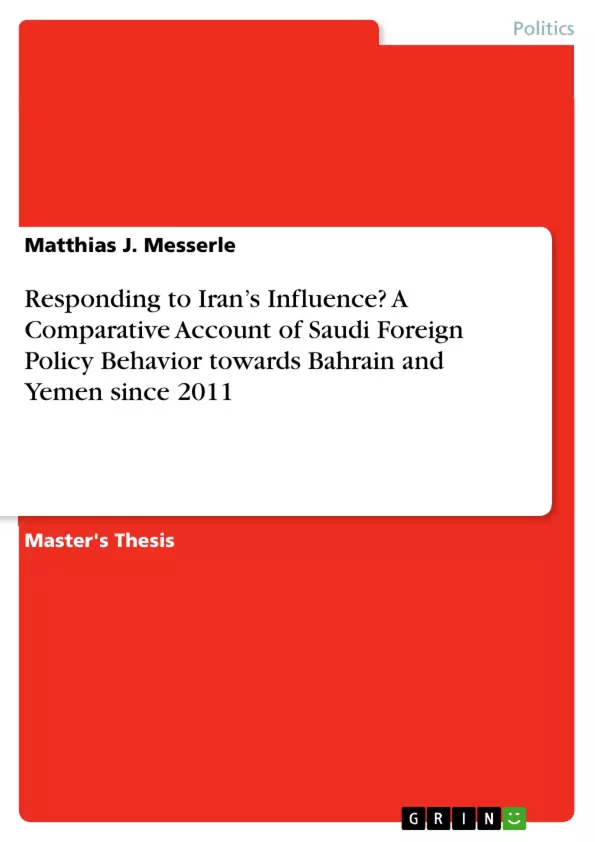In this research project, I will shed light on Bahrain and Yemen. More precisely, I will scrutinize the foreign policy behaviour of Saudi Arabia in these two cases, starting in early 2011. The year 2011 is significant because it marks the beginning of popular uprisings across the Arab world, soon to be referred to as the “Arab Spring”. Bahrain and Yemen represent two cases in which an uprising against the ruling regime led to two different outcomes: Repression (Bahrain) and war (Yemen). In both cases, Saudi Arabia, along with other Gulf states, intervened in a neighboring country to support allied governments fighting their opposition (or a rebel movement, as in Yemen).
Bahrain and Yemen are both countries with significant Shiʿa populations, amplifying Saudi fears of growing Iranian influence in these communities. Based on the evidence of Iranian involvement in Syria, Lebanon and Iraq, I assume that Iran has played a role in Bahrain and Yemen, too. The extent to which Saudi policies in these two cases have been informed by Iran’s influence will be at the center of this study’s inquiry.
Inhaltsverzeichnis (Table of Contents)
- Hypotheses
- Introduction
- International Relations (IR) Theory / Hypotheses ...
- Realism
- Foreign Policy Analysis (FPA).
- The Case of Bahrain.
- Saudi-Bahraini links.
- Iranian-Bahraini links...
- The uprising in 2011
- Saudi policies towards Bahrain
- The Case of Yemen ..
- Saudi-Yemeni links..
- Iranian-Yemeni links..
- The war in Yemen.......
- Saudi policies towards Yemen.
- Evaluation of Hypotheses.........
- Conclusion.....
Zielsetzung und Themenschwerpunkte (Objectives and Key Themes)
This master's thesis seeks to understand the nature and motivation behind Saudi Arabia's foreign policy behavior towards Bahrain and Yemen, specifically in response to Iranian influence. The thesis analyzes the historical and political contexts of both countries, focusing on the dynamics of Saudi-Iranian rivalry and its impact on these two states. The analysis utilizes a comparative approach, examining Saudi policies in each country through the lens of International Relations theory and Foreign Policy Analysis.
- Saudi foreign policy response to Iranian influence.
- Comparative analysis of Saudi policy in Bahrain and Yemen.
- The role of Saudi-Iranian rivalry in regional dynamics.
- The impact of the 2011 uprisings on Saudi foreign policy.
- The interplay of domestic and international factors in Saudi policy decision-making.
Zusammenfassung der Kapitel (Chapter Summaries)
The introduction of the thesis sets the stage by framing the Saudi-Iranian rivalry as a regional "Cold War" and outlining the theoretical framework for the study. It introduces key concepts such as realism and foreign policy analysis.
The chapter on Bahrain focuses on the historical and contemporary relations between Saudi Arabia and Bahrain, tracing the development of their political and economic ties. It then explores Iranian involvement in Bahrain, particularly in the context of the 2011 uprisings, and examines Saudi Arabia's response to these developments.
The chapter on Yemen delves into the historical and contemporary ties between Saudi Arabia and Yemen, emphasizing the political and economic dimensions of their relationship. It analyzes the dynamics of Iranian involvement in Yemen, including the role of Houthi rebels, and scrutinizes Saudi Arabia's policy responses, including military interventions.
Schlüsselwörter (Keywords)
The key terms and concepts explored in this thesis include: Saudi Arabia, Iran, Bahrain, Yemen, foreign policy, regional rivalry, Cold War, International Relations, realism, foreign policy analysis, proxy conflicts, sectarianism, Salafism, Wahhabism, uprisings, 2011 Arab Spring, Houthi rebels, regional hegemony.
- Quote paper
- Matthias J. Messerle (Author), 2022, Responding to Iran’s Influence? A Comparative Account of Saudi Foreign Policy Behavior towards Bahrain and Yemen since 2011, Munich, GRIN Verlag, https://www.grin.com/document/1268818



